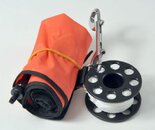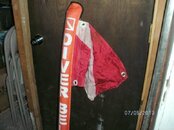i always use some sort of surface float with a legal dive flag presented on it. I fly a flag on my kayak when kayak diving or if beach/shore diving I tow a float with the flag. One of the floats I tow is a car inner tube with a mesh bottom. I also have a torpedo float I tow also with a flag. I have an old Pelican end over type reel I use with them. But I have also repurposed one of my old cave reels for the same job.
I also just about always carry a DSMB. Some years ago on a six pack out of Pensacola I was dropped with my two buddies on a wreck. Upon arriving at the wreck, I realized the wreck had broken in two. I could see marks on the sea floor, that indicated to me that perhaps a winter storm or some storm had pushed the now two wrecks apart. I signaled to my buddies to follow me and they both nodded and so I went off on to the sand. Only to look around and realize they had remained on the "little" piece the captain put us down on and had anchored up on. Well, okay, I could now see the main part of the wreck and so I carried on (bad, bad Nemrod). I had a great dive, got some nice photos, a lot of critters and a great solo dive. Well, the current, especially at the surface was strong and there were about three foot seas running. I had bumped into deco but I had plenty of air and knew the deco obligation would resolve itself as soon as I hit 30 feet (and it did). But still, I did a two minute stop at 30 feet and then my "safety stop" at 15 feet. I knew that five minutes at stops plus ascent time adrift in the current would put me far away from the anchored six pack (and it did). So, I shot my DSMB from the wreck at 90 feet after reaching it and hooking it off to a rail. Then, upon deciding I was enough into deco, returned, grabbed my reel and began my ascent reeling up my line as I ascended.
The captain was happy that he could see my buoy and he knew we had split up below. My buddies had come up and he was pulling anchor, I had drifted about a quarter mile or more before he could get the anchor up and get under way but all along my DSMB was clearly visible.
N
I also just about always carry a DSMB. Some years ago on a six pack out of Pensacola I was dropped with my two buddies on a wreck. Upon arriving at the wreck, I realized the wreck had broken in two. I could see marks on the sea floor, that indicated to me that perhaps a winter storm or some storm had pushed the now two wrecks apart. I signaled to my buddies to follow me and they both nodded and so I went off on to the sand. Only to look around and realize they had remained on the "little" piece the captain put us down on and had anchored up on. Well, okay, I could now see the main part of the wreck and so I carried on (bad, bad Nemrod). I had a great dive, got some nice photos, a lot of critters and a great solo dive. Well, the current, especially at the surface was strong and there were about three foot seas running. I had bumped into deco but I had plenty of air and knew the deco obligation would resolve itself as soon as I hit 30 feet (and it did). But still, I did a two minute stop at 30 feet and then my "safety stop" at 15 feet. I knew that five minutes at stops plus ascent time adrift in the current would put me far away from the anchored six pack (and it did). So, I shot my DSMB from the wreck at 90 feet after reaching it and hooking it off to a rail. Then, upon deciding I was enough into deco, returned, grabbed my reel and began my ascent reeling up my line as I ascended.
The captain was happy that he could see my buoy and he knew we had split up below. My buddies had come up and he was pulling anchor, I had drifted about a quarter mile or more before he could get the anchor up and get under way but all along my DSMB was clearly visible.
N















